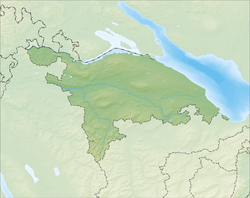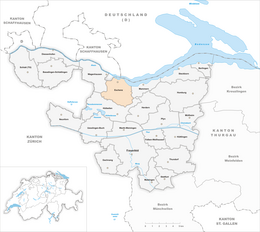Eschenz
| Eschenz | ||
|---|---|---|
 |
||
|
||
| Coordinates: 47°39′N 8°52′E / 47.650°N 8.867°ECoordinates: 47°39′N 8°52′E / 47.650°N 8.867°E | ||
| Country | Switzerland | |
| Canton | Thurgau | |
| District | Frauenfeld | |
| Area | ||
| • Total | 12.01 km2 (4.64 sq mi) | |
| Elevation | 412 m (1,352 ft) | |
| Population (Dec 2015) | ||
| • Total | 1,725 | |
| • Density | 140/km2 (370/sq mi) | |
| Postal code | 8264 | |
| SFOS number | 4806 | |
| Surrounded by | Hüttwilen, Mammern, Öhningen (DE-BW), Stein am Rhein (SH), Wagenhausen | |
| Website |
www SFSO statistics |
|
Eschenz is a municipality in Frauenfeld District in the canton of Thurgau in Switzerland.
The prehistoric shore village on Werd Island and in the Seeäckern area (northeast of Eschenz) are rich archeological sites that have contributed substantially to our understanding of the history of settlements in the narrow area around Lake Constance. The two sites remained settled throughout the prehistoric epoch and into the early historical era. In 1858, the settlement site was discovered on the main island. The excavation in 1882-83 by Schenk was followed by a second expedition in 1931-36 by Karl Keller Tarnuzzer. There was a smaller excavation in 1962 around the St. Otmars Chapel.
The first settlement of the island was made shortly after BC 4000th (Early Pfyn culture) and was part of a migration into subalpine wetlands during the beginning of the late Neolithic era. A second settlement phase (late Pfyn culture) began after long break during the middle of the 4th millennium. This was followed by a third phase of settlement (Horgen culture, 2nd half of 4th millennium). After this phase, an increase in the lake level put the entire island under water during the first half of the 3rd millennium. The next settlement wasn't until the mid-Late Bronze Age (11th century BC). The lake waters rose again, interrupting the island settlements until the final phase of the Late Bronze Age (9th century BC). During this time, parts of a number of horse bridles were discovered, indicating that the island may have been a transportation hub due to its convenient location.
The Roman era Vicus of Tasgetium which developed south of the Rhine Bridge, probably in the 2nd and 3rd Centuries, had its nucleus in Untereschenz. The settlement grew into the Kastell auf Burg in Stein am Rhein, which, together with fortifications in Pfyn and Arbon provided the Roman border defenses around Lake Constance.
...
Wikipedia




